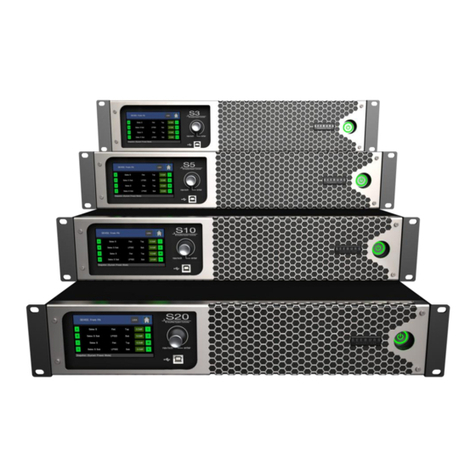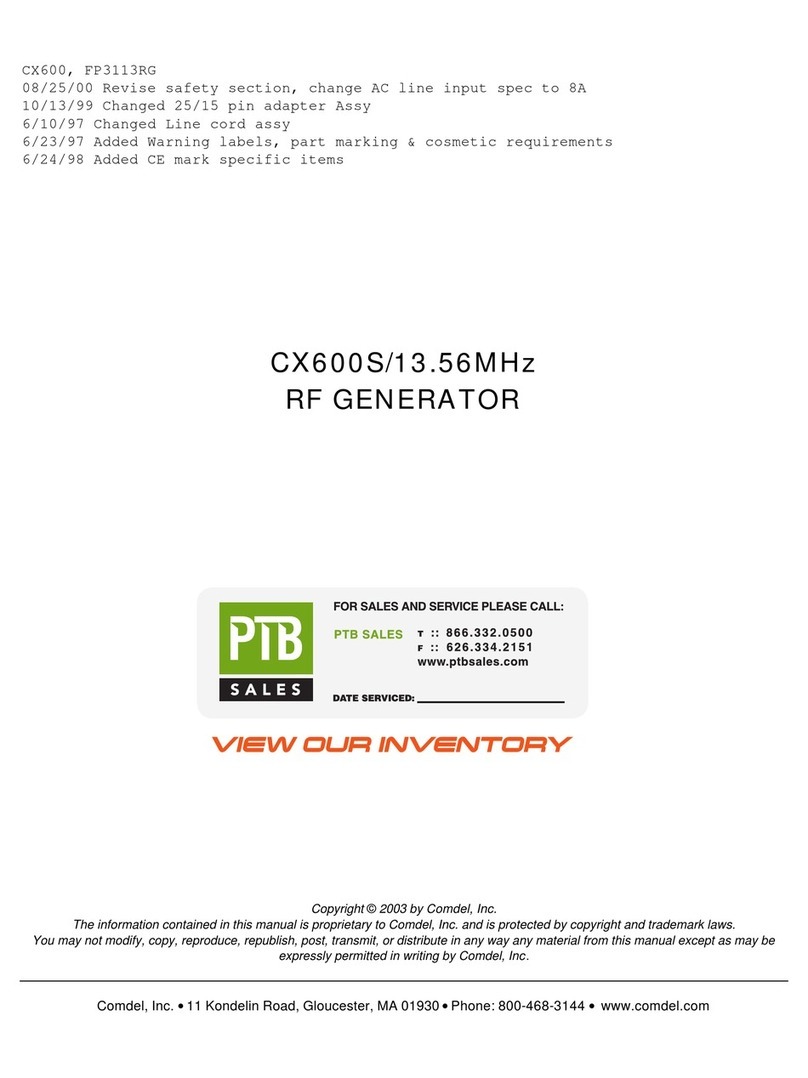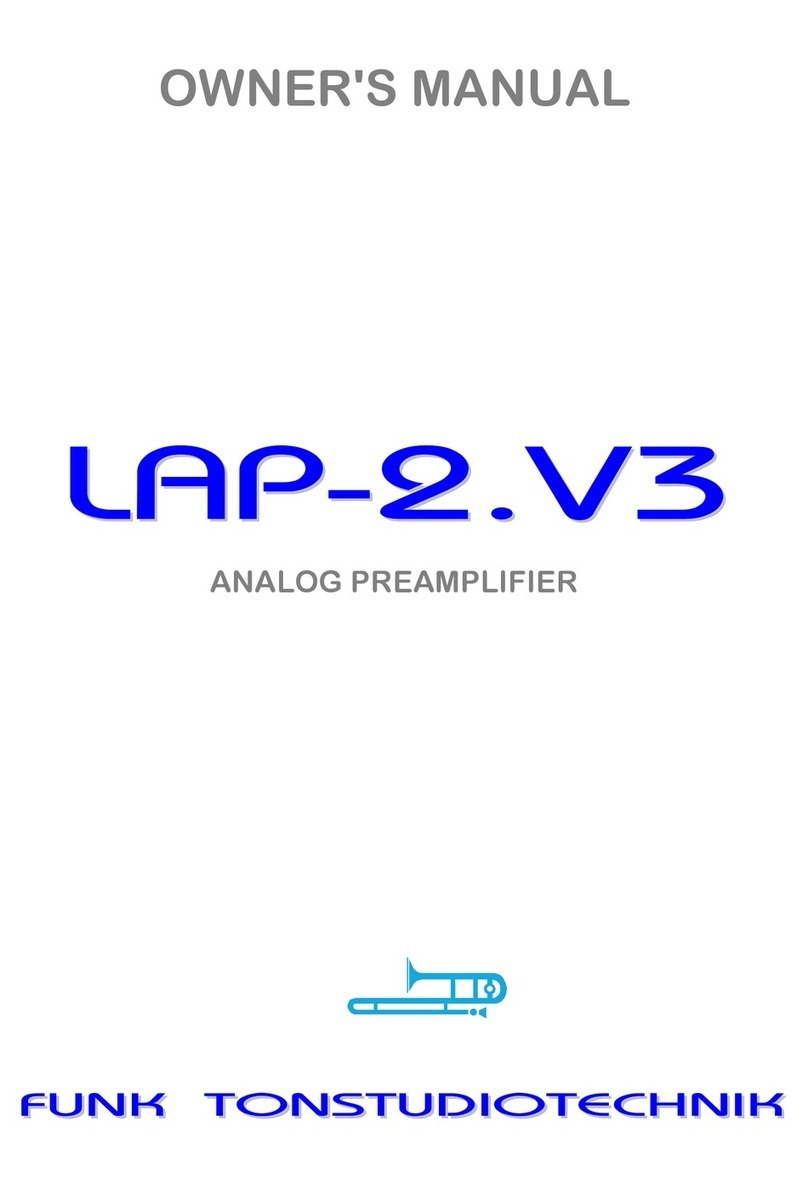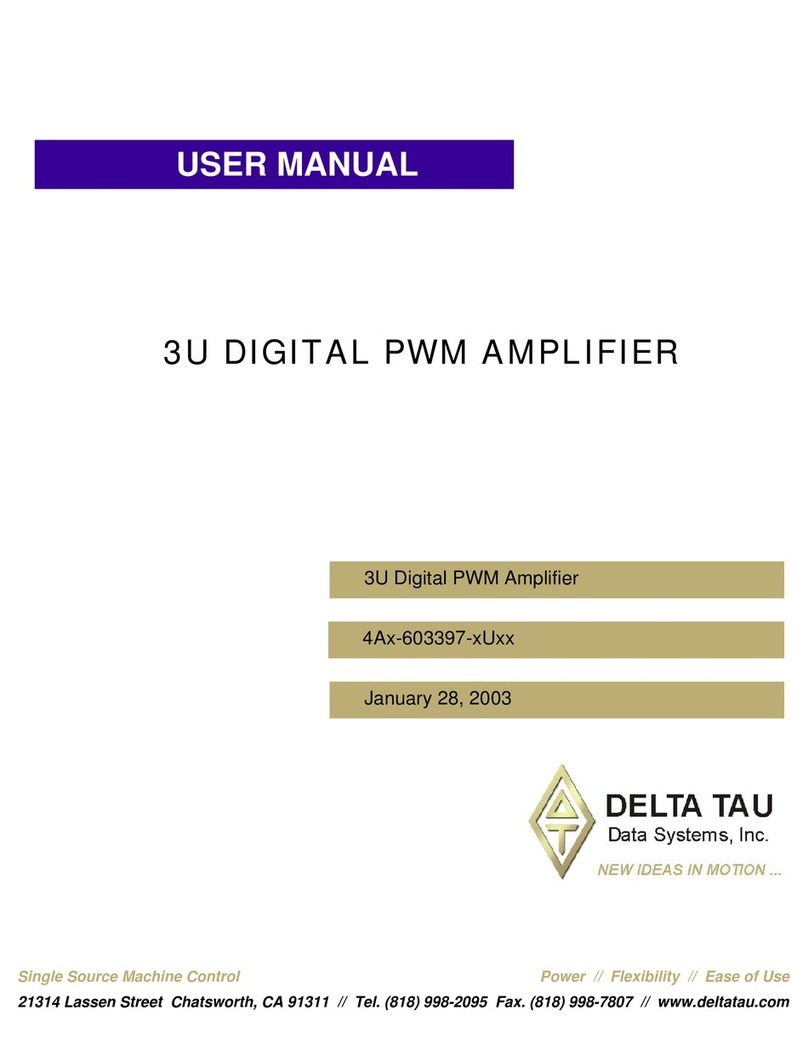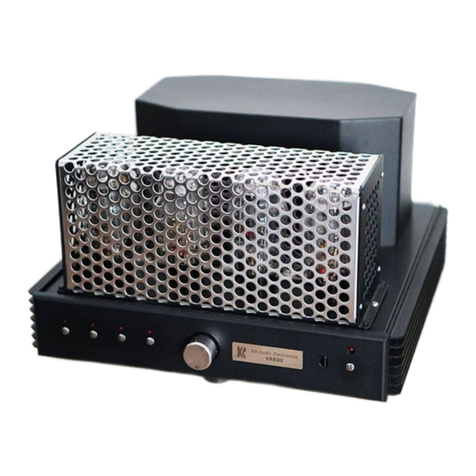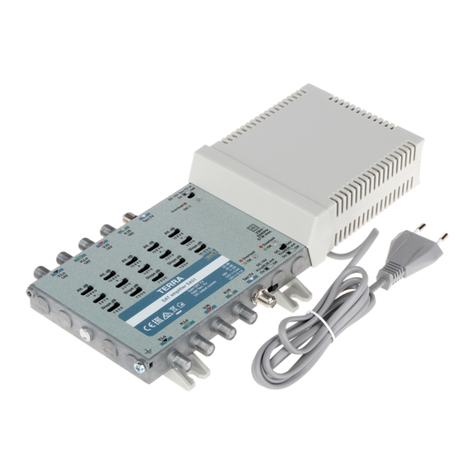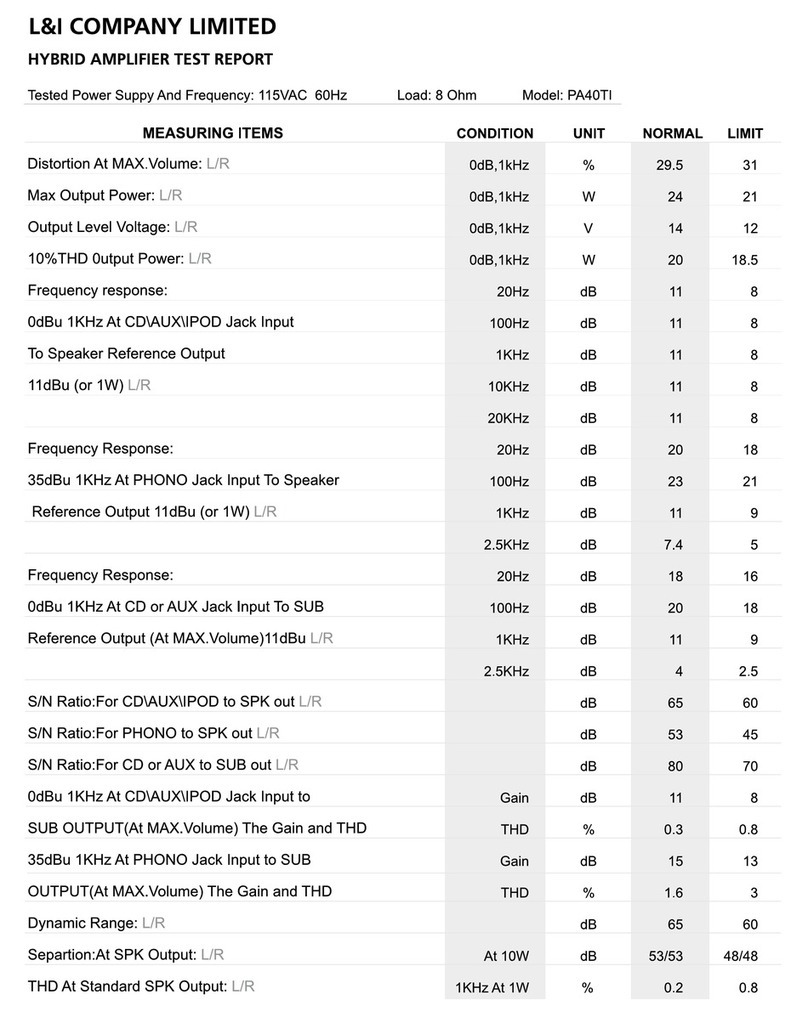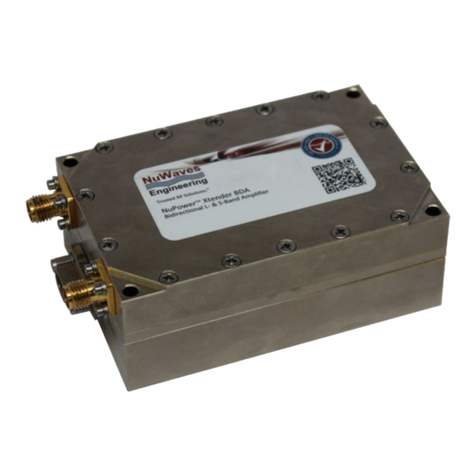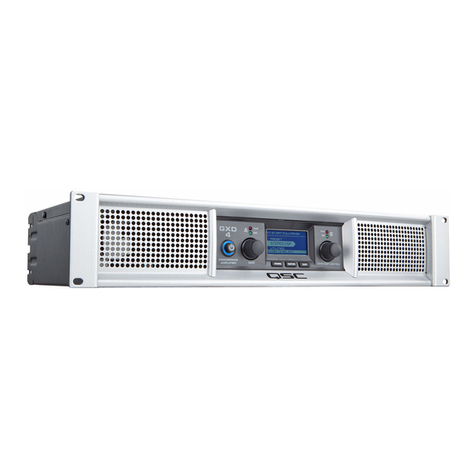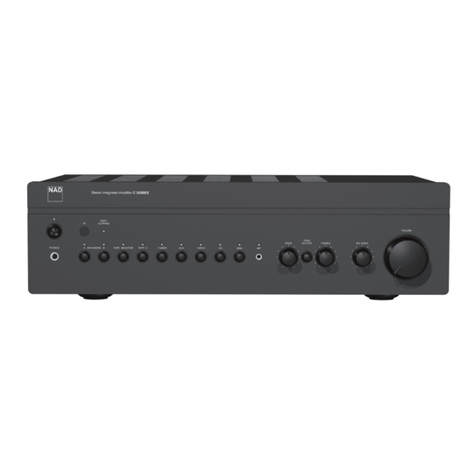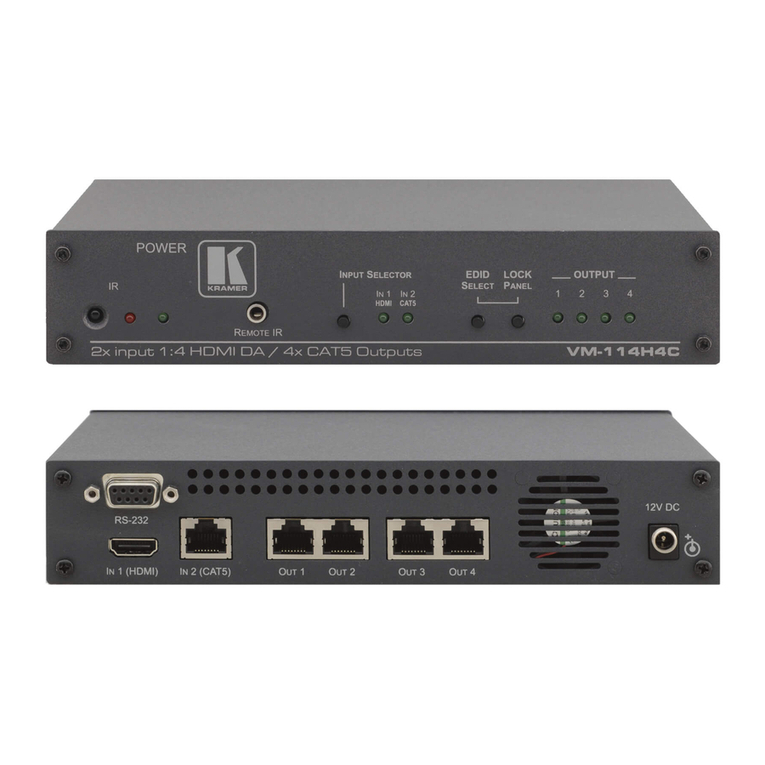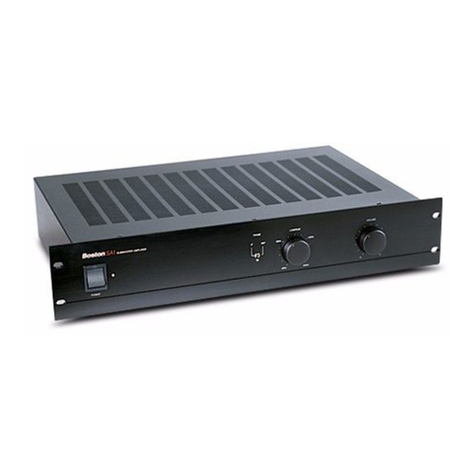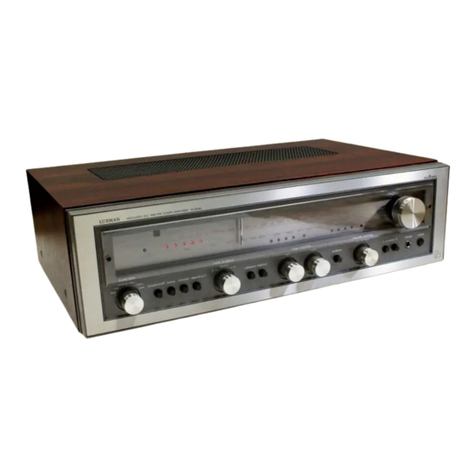Seeburg Powerstick User manual

User Manual
Powerstick
Version 3.1
14.08.2020

Powerstick
1 Contents
2
1Contents
1Contents ..................................................................................................................................... 2
2Foreword..................................................................................................................................... 4
3Safety instructions.................................................................................................................... 5
4Connectors/Indicators.............................................................................................................. 7
4.1 Connection panel...............................................................................................................................7
4.2 Connectors .........................................................................................................................................8
4.3 Controls...............................................................................................................................................9
4.4 Status indication.................................................................................................................................9
5Operation.................................................................................................................................. 10
5.1 Starting up.........................................................................................................................................10
5.2 Selecting a bank ..............................................................................................................................10
5.3 Setting level......................................................................................................................................11
5.4 Recalling presets .............................................................................................................................11
5.4.1 Preset Bank 1 –L-Series.................................................................................................................................11
5.4.2 Preset Bank 2 –Default Settings....................................................................................................................12
5.4.3 Preset Bank 3 –i-Series..................................................................................................................................13
5.5 Locking the buttons .........................................................................................................................13
6Programming the DSP............................................................................................................ 14
6.1 Generating a preset audio file........................................................................................................14
6.2 Preset structure (example).............................................................................................................15
6.3 Overview over the LPI text commands.........................................................................................16

Powerstick
1 Contents
3
6.4 LPI text commands in detail...........................................................................................................17
6.4.1 All-pass filter......................................................................................................................................................17
6.4.2 Preset bank........................................................................................................................................................17
6.4.3 Preset.................................................................................................................................................................17
6.4.4 Channel selection.............................................................................................................................................18
6.4.5 Comment............................................................................................................................................................18
6.4.6 Delay...................................................................................................................................................................18
6.4.7 Level...................................................................................................................................................................19
6.4.8 High-pass filter ..................................................................................................................................................19
6.4.9 Low-pass filter...................................................................................................................................................20
6.4.10 High-Shelf..........................................................................................................................................................20
6.4.11 Low-Shelf...........................................................................................................................................................21
6.4.12 Parametric EQ...................................................................................................................................................21
6.4.13 Polarity................................................................................................................................................................21
6.4.14 Limiter.................................................................................................................................................................22
6.4.15 Release time......................................................................................................................................................22
6.4.16 RMS time ...........................................................................................................................................................23
6.4.17 Peak time...........................................................................................................................................................23
6.4.18 Volume-Control.................................................................................................................................................23
6.5 Reprogramming the Powerstick with preset audio files.............................................................24
7Technical specifications ........................................................................................................ 25
8Declaration of conformity...................................................................................................... 26

Powerstick
2 Foreword
4
2Foreword
The Powerstick is an ultra compact and especially low weight amplifier with 2x 500 Watt power @
4 Ohm (AES) and integrated DSP Controller.
It is designed for installation in the stand columns (monopods) of the L-series and can also be
docked directly on the back of the L-series line source speakers. Due to its design and the various
mounting options, the power stick also can be used as a single device or can be integrated in e.g.
truss constructions or exhibition stands. Various pre-configured presets and level settings are
available for selection.
The integrated DSP controller is based on the same operating principle as the stand-alone control-
lers HDLM 8 and DSP 2.6. A mere 0.8 ms latency (from analogue input to output) is achieved
through the use of a 96 kHz sample rate. The excellent signal to noise ratio is a further feature of
the DSP controller. Electronic simulation of a transformer balanced input provides additional pro-
tection against hum and buzz caused for example by external interference. High grade electronic
components from the industrial sector and first-class circuit design result in a robust device with
excellent audio characteristics and minimize disruptive noise.
The default state of the integrated DSP controller is the standard configuration as described in this
manual. Custom presets can be installed by the user himself because only a special audio file has
to be generated and installed. This preset audio file can be programmed with the LPI (Loudspeaker
Programming Interface) also by the user himself. The preset file is a custom audio file which is
simply played into the audio input of the controller. In this manner, individual settings for different
speaker combinations can be created. Furthermore, should you ever be unsure as to the integrity
of the DSP configuration of your controller, you can obtain a fresh default file from SEEBURG
acoustic line and re-install the original factory presets yourself. Efficient and intelligent limiter func-
tions provide optimal protection without sacrificing any of the potential of the system.
If you would like further information about SEEBURG acoustic line products, or have any com-
ments or suggestions regarding this handbook or the product, you can contact us here:
SEEBURG acoustic line Produktions- und Vertriebsgesellschaft mbH
Auweg 32
89231 Senden
07307 / 9700 –0
www.seeburg.com

Powerstick
3 Safety instructions
5
3Safety instructions
Acoustic
Even a low input level can result in a sound pressure level at the
loudspeaker which can be damaging to your hearing. Do not remain
in close proximity to the loudspeaker when it is being operated. Use
hearing protection. Observe all relevant Health and Safety and Envi-
ronmental Protection regulations.
Mechanical
Movable parts and falling objects during installation and de-rigging
can cause serious injury. Observe at all times all relevant Health and
Safety regulations and regulations on the installation and operation of
PA systems.
Magnetic und electrical
Loudspeakers generate a magnetic field even without a source of
power connected. This can damage or destroy magnetic storage
devices. The PowerCon loop-through connector is under power when
the device is in operation. Observe all relevant safety regulations at
all times.
General safety precautions
The installation and de-rigging of this equipment should only be car-
ried out by appropriately qualified and experienced personnel, and
according to all relevant safety regulations. Find out about the appli-
cable regulations in the country you work in and comply with the re-
spective regulations.
Do not operate the Powerstick if you have any doubts about the safe-
ty of doing so, or if the loudspeaker shows any signs of faulty opera-
tion. There are no user serviceable parts inside the device. For
repairs, contact your dealer or a qualified service technician.
The Powerstick is a class 1 device requiring a 230 V / 50 Hz power
connection with earth contact.

Powerstick
3 Safety instructions
6
If the loudspeaker is connected to a power source in which the volt-
age is too high, a protective mechanism is triggered which reliably
safeguards the amplifier module and DSP. Once triggered, the pro-
tection must be renewed by a qualified service technician.
Never open the housing. There are no user serviceable parts inside.
Do not expose the Powerstick to rain, and avoid operating in envi-
ronments below -5° C or above 40° C. Be aware of the possibility of
condensation forming inside the housing due to rapid changes in
temperature. Allow the Powerstick to adjust to ambient temperature
before operation. Leave the device switched on if operating in unfa-
vorable conditions.
To prevent overheating, do not operate the Powerstick in the direct
vicinity of strong heat sources, and avoid direct sunlight. After long
periods of operation, the housing, particularly metallic components
such as the rear panel and the connector panel, can reach tempera-
tures exceeding 40° C.

Powerstick
4 Connectors/Indicators
7
4Connectors/Indicators
4.1 Connection panel
SpeakON black (5)
XLR connectors (1)
PowerCon blue (2)
SpeakON black (4)
SpeakON black (3)

Powerstick
4 Connectors/Indicators
8
4.2 Connectors
XLR connectors (1)
The Powerstick should be connected with a standard symmetrically wired XLR cable. To connect
the input signal to further devices, use the male XLR Loop thru connector. To obtain full power
performance from the system, the signal source should be able to provide a minimum of 6 dBu
distortion free output voltage.
PowerCon blue (2)
Power supply input voltage 110-230 VAC. This connector provides the function of an on-off switch.
After powering on (turn the connector to the right until it locks), the systems starts up and is ready
for use after approximately 3 seconds. Avoid repeatedly switching the system on and off, particular-
ly when it is operating.
SpeakON (3)
This connector is used to connect additional passive loudspeakers to amplifier channel 1.
Coding: „1+/1- Out 1“. ATTENTION! The nominal impedance of the connected passive systems
must be 4 Ohm or more! In this connection mind the selection of the correct controller setup!
SpeakON (4)
This connector is used to connect additional passive loudspeakers to amplifier channel 2.
Coding: „1+/1- Out 2“. ATTENTION! The nominal impedance of the connected passive systems
must be 4 Ohm or more! In this connection mind the selection of the correct controller setup!
SpeakON (5)
This connector is used to connect a passive mid-high system in combination with a subwoofer sys-
tem by using system wiring.
Coding: „1+/1- Out 1“ and „2+/2- Out 2“. ATTENTION! The nominal impedance of the connected
passive systems must be 4 Ohm or more on both the „1+/- group“and the „2+/- group“! In this con-
nection mind the selection of the correct controller setup!
The nominal power consumption of the Powerstick under full power is
0.75 A (measured with pink noise, Crest Factor 8). Transient peaks
can, however, cause much higher momentary power drain. Observe
carefully the nominal power consumption when connecting the loud-
speaker(s) to the power source, and observe carefully the cut-off
current of the safety circuit breakers. We recommend using the loud-
speaker on power circuits with circuit breakers with C characteristic.

Powerstick
4 Connectors/Indicators
9
4.3 Controls
Mode button:
Switch between the modes Status / Level and Presets.
Set button:
Set various values and Mute on/off.
4.4 Status indication
Mute LED:
Lights red when the system is muted (press the Set button in Status
Mode), or in technically critical conditions.
Limit LED:
Lights yellow when the limiter is limiting one or more amplifier chan-
nels.
Signal LED:
Lights green when a signal of more than -20 dBu is present. The LED
still lights up when the system is muted.
Power LED:
Lights when the system is powered up.

Powerstick
5 Operation
10
5Operation
5.1 Starting up
The last settings are restored when the device is switched on. This also applies to the choice of the
preset bank. When the start-up is completed, the system is in status mode. If the red Mute LED
lights up depending on the previous setting, no signal is being transmitted. Pressing the set button
once deactivates the mute function, the mute LED will go off and the system is ready for operation.
5.2 Selecting a bank
The loudspeaker presets are stored in the DSP controller in up to 3
banks. To change banks, press and hold the Mode button whilst the
loudspeaker is switched on.
1. Press and hold the Mode button.
2. Connect the power cable (PowerCon blue).
3. Corresponding LEDs blink to indicate the chosen bank.
4. Release the Mode button.
When the power cable is connected, the level and/or preset LED
lamps blink to indicate which bank is selected. The level LED blinks
to indicate the first bank, the preset LED for the second. The third
bank is indicated by both LEDs blinking.
If only one bank is programmed, there is no possibility to switch the
bank.
Bank 1 –L-Series
Bank 2 –Default Settings
Bank 3 –i-Series
2x L16 Fullrange
2x HP 50Hz
2x i4 Flat
2x L16 HP 180Hz
2x Low-Boost
2x i5 Flat
L16 HP + G Sub 1201 160Hz
Top + Sub 160Hz
i4 HP + G Sub 1001 160Hz
L16 HP + G Sub 1501 140Hz
Top + Sub 120Hz
i5 HP + G Sub 1001 120Hz

Powerstick
5 Operation
11
5.3 Setting level
Pressing the Mode button once selects the Level Mode, in which you
can adjust the output volume in 3 dB steps. There are four settings
available: +3 dB, 0 dB (standard), -3 dB and -6 dB. The setting is
done by pressing the Set button. The Level LED lights to indicate
which mode is activated. The four vertically aligned LEDs (lit green in
this mode) indicate which setting is selected.
ATTENTION! The level settings apply only to the first amplifier
channel which powers the SpeakON socket (3) and the „1+/- group“
of SpeakON socket (5) when the factory setting is programmed. It’s
possible to modify this setting (see 6.4.18).
5.4 Recalling presets
Pressing the Mode button twice selects the Preset Mode. Three different presets with an each
switchable Cardioid Mode are available in each bank for selection via the Set button. The four ver-
tically aligned LEDs indicate the current selection.
5.4.1 Preset Bank 1 –L-Series
1 -Fullrange:
Preset for use when L16 i/j are connected to SpeakON sockets (3)
and (4) and are set up standalone. This setting is useful in full-range
applications in which strong bass reproduction is required, but a sub-
woofer cannot be used. The achievable low-frequency level is, how-
ever, limited.
2 -2x L16 HP 180Hz:
Preset for use when L16 i/j are connected to SpeakON sockets (3)
and (4) and higher maximum sound pressure level is required.
3 -L16 HP + G Sub 1201 160Hz:
Preset for use when L16 i/j are connected to SpeakON socket (3) in
combination with up to 2 G Sub 1201 on SpeakON socket (5). The
acoustical cross-over frequency in this preset is approx. 160 Hz.
4 -L16 HP + G Sub 1501 140Hz:
Preset for use when L16 i/j are connected to SpeakON socket (3) in
combination with up to 2 G Sub 1501 on SpeakON socket (5). The
acoustical cross-over frequency in this preset is approx. 140 Hz.

Powerstick
5 Operation
12
5.4.2 Preset Bank 2 –Default Settings
1 -2x HP 50 Hz:
Preset for use when the second amplifier channel is powering a mid-
high system (e.g. X1, A2 or X4) connected to SpeakON sockets (3)
and (4). The high-pass filter at 50 Hz is a protection high-pass.
2 -2x Low-Boost:
Flat preset with a low-frequency boost for use when the second am-
plifier channel is powering a mid-high system (e.g. X1, A2 or X4) con-
nected to SpeakON sockets (3) and (4). This setting is useful in full-
range applications in which strong bass reproduction is required, but
a subwoofer cannot be used. The achievable low-frequency level is,
however, limited.
3 -Top + Sub 160 Hz:
Preset with a higher cross-over frequency for use when smaller mid-
high systems (e.g. A1 or X1) are connected to SpeakON socket (3) in
combination with a subwoofer system (at min. 4 Ohm) on SpeakON
socket (5). The cross-over frequency in this preset is approx. 160 Hz.
4 -Top + Sub 120 Hz:
Preset with a higher cross-over frequency for use when mid-high
systems (e.g. A3 or X4) are connected to SpeakON socket (3) in
combination with a subwoofer system (at min. 4 Ohm) on SpeakON
socket (5). The cross-over frequency in this preset is approx. 120 Hz.

Powerstick
5 Operation
13
5.4.3 Preset Bank 3 –i-Series
1 -2x i4 Flat:
Preset for use when i4 are connected to SpeakON sockets (3) and
(4).
2 -2x i5 Flat:
Preset for use when i5 are connected to SpeakON sockets (3) and
(4).
3 -i4 HP + G Sub 1001 160 Hz:
Preset for use when i4 are connected to SpeakON socket (3) in com-
bination with up to 2 G Sub 1001 on SpeakON socket (5). The acous-
tical cross-over frequency in this preset is approx. 160 Hz.
4 -i5 HP + G Sub 1001 120 Hz:
Preset for use when i5 are connected to SpeakON socket (3) in com-
bination with up to 2 G Sub 1001 on SpeakON socket (5). The acous-
tical cross-over frequency in this preset is approx. 120 Hz.
5.5 Locking the buttons
Press and hold the Set and Mode buttons simultaneously for more
than 3 seconds to lock the controls of the system. Repeat the action
to unlock the system.

Powerstick
6 Programming the DSP
14
6Programming the DSP
6.1 Generating a preset audio file
The presets are written in text-form using a simple description language. This procedure, originally
developed for the Seeburg HDLM 8, enables the professional creation of speaker setups without
having to deal with the otherwise confusing and difficult to understand software solutions.
You can print the description text of a created preset and archive it or save it in a ".txt" file so that
you can use it again later. The form of the descriptive language is kept quite simple that any skilled
personnel can read and interpret it immediately, even years later.
The description language is called LPI: Loudspeaker Programming Interface.
The preset audio file is created in a web app. This app can be found in the internet under:
http://seeburg.net/lpi
On this site the option to download the app for offline use is provided. The only requirement there-
fore is a browser compatible to HTML 5.
The created preset can be downloaded in the LPI app (after the preset text has been confirmed via
„Apply“) as a “.wav” file or it can be played directly into the Powerstick via the audio output of the
PC. This file contains the created presets and is programmed onto the power stick as described in
section Fehler! Verweisquelle konnte nicht gefunden werden.. To activate the programming
function, the set button must be pressed in Status Mode to mute the power stick.
Steps for programming the Powerstick:
1. Write preset text in the LPI (or change an existing example preset)
2. Confirm with „Apply“
3. If desired, save the preset text as a text document for later reuse
4. Download the „-wav“ file
5. Play as explained in section 6.5 (the audio file can also be played directly from the LPI)

Powerstick
6 Programming the DSP
15
6.2 Preset structure (example)
powerstick
Bank "3 I-Series"
preset "I5 HP + G Sub 1001 120Hz"
input
gain +6dB #adaption to 32dB ampgain
# place EQ’s here if required
out 1
volcontrol
#i5 HP
gain +0dB
phase nor
power 16R 120W 360W 26dB #amp module has 26dB ampgain!
rmstime 250ms
peaktime 50ms
hpf BW18 140Hz
peq 850Hz Q2 3dB
peq 1100Hz Q3 -2dB
peq 1880Hz Q3 -3dB
peq 7000Hz Q2 2dB
peq 15000Hz Q3 6dB
out 2
#GSub1001 120Hz
gain +6db
phase nor
power 8R 300W 1200W 26dB #amp module has 26dB ampgain!
rmstime 1000ms
peaktime 100ms
hpf BW12 54Hz
lpf LR24 120Hz
peq 54Hz Q2 +3dB
peq 80Hz Q2 +1.5dB
peq 250Hz Q1 -6dB
peq 310Hz Q8 -5dB

Powerstick
6 Programming the DSP
16
6.3 Overview over the LPI text commands
Filter
Notation
Definition
All-pass filter
apf [Q<q>] [< frequency>Hz|kHz ]
Defines an all-pass filter. When Q is set, an all-pass filter
2nd order is implemented
Bank
bank "<labeling>"
Defines the preset bank. For each bank the same number
of presets must be programmed
Preset
preset "<labeling>"
Defines a preset which includes the loudspeaker data for
the two outputs
Channel selection
out 1|out 2
Selects the DSP- and amp channel Out 1 or Out 2
Comment
# <text>
The text following the pound sign is ignored by the DSP
Delay
delay <time>ms
Sets the time delay in milliseconds
Level
gain <value>dB
Increase or decrease of the level of the channel
High-pass filter
hpf [characteristic] [< frequency>Hz|kHz]
Defines a high-pass filter with selectable characteristic
(Butterworth, Bessel or Linkwitz-Riley with different
selectable slew rate) at a certain frequency
Low-pass filter
lpf [characteristic] [< frequency>Hz|kHz]
Defines a low-pass filter with selectable characteristic
(Butterworth, Bessel or Linkwitz-Riley with different
selectable slew rate) at a certain frequency
High-Shelf
hshelf [6/12] [< frequency>Hz|kHz] [<gain>dB]
Defines a high frequency shelving filter. The frequency
defines the middle of the filter
Low-Shelf
lshelf [6/12] [< frequency>Hz|kHz] [<gain>dB]
Defines a low frequency shelving filter. The frequency
defines the middle of the filter
Parametric EQ
Peq [Q<q>] [< frequency>Hz|kHz] [<gain>dB]
Defines a parametric EQ with frequency, Q factor and
gain
Polarity
phase nor / rev
Defines the polarity of the channel
Limiter
power [<impedance>R] [<thermal power>W]
[<peak power>W] [<amp-gain>dB]
Sets limiter values for the selected DSP channel
Release time
releasetime <time>ms
Sets the release time of the limiters
RMS time
rmstime <time>ms
Sets the averaging time of the RMS measurement for the
limiter
Peak time
peaktime <time>ms
Sets the averaging time of the peak measurement for the
limiter
Volume-Control
volcontrol
Defines the DSP- or amp channel which whose volume
can be set on the operation panel

Powerstick
6 Programming the DSP
17
6.4 LPI text commands in detail
6.4.1 All-pass filter
Definition:
apf [Q<q>] [< frequency>Hz|kHz]
Description:
Defines an all-pass filter. When Q is set, an all-pass filter 2nd order is imple-
mented.
Example(s):
apf 250Hz
apf 200Hz Q3.5
# all-pass 1st order
# all-pass 2nd order
6.4.2 Preset bank
Definition:
bank "<labeling>"
Description:
Creates a new preset bank. Each preset bank must have the same number of
presets. Due to the labeling of the control panel it’s recommended to program a
maximum of three preset bank with each four presets.
Example(s):
Bank 1 „L-Series“
# defines preset bank 1 under the
name „L-Series“
6.4.3 Preset
Definition:
preset "< labeling>"
Description:
Defines a preset which includes the loudspeaker data for the two outputs. The
LPI processes all text commands until the next line below in which the text
command „Preset“ or „Bank“ is used. For each preset bank we recommend a
maximum of four presets.
Example(s):
Preset 3 „i5 + G Sub 1001 120Hz“
# defines a Preset named „i5 + G Sub
1001 120Hz“ from this line on

Powerstick
6 Programming the DSP
18
6.4.4 Channel selection
Definition:
Input | Out 1 | Out 2
Description:
Selects the DSP- and amp channel Out 1 or Out 2. For the selected channel
the LPI processes all text commands until the next line below in which the text
command for channel selection or the text command „Preset“ or „Bank“ is used.
Example(s):
Input
gain +6dB
Out 2
hpf BW18 50Hz
# refers to both DSP and amp chan-
nels within the preset
# selects DSP-/Amp channel 2
6.4.5 Comment
Definition:
#
Description:
To write a comment in a line, a pound sign (#) is set in front of the text. The text
following the pound sign is ignored by the DSP.
Example(s):
# comment
# this text is painted green and simply
serves as documentation or labeling
function
6.4.6 Delay
Definition:
delay <time>ms
Description:
Sets the time delay in milliseconds.
Example(s):
delay 2.3ms
The channel in which this command is
used gets delayed by 2.3 ms

Powerstick
6 Programming the DSP
19
6.4.7 Level
Definition:
gain <Wert>dB
Description:
Sets the increase or decrease of the level of the channel.
Example(s):
gain -3.5dB
The level of the channel in which this
command is used gets decreased by
3.5 dB
6.4.8 High-pass filter
Definition:
hpf [characteristic] [< frequency>Hz|kHz]
Description:
Defines a high-pass filter with a certain characteristic at a specified frequency
(-3 dB point). The characteristic can be programmed as slew rate in Q factor or
as follows:
• Butterworth characteristic, 6 up to 48 dB per octave in 6 dB steps
• BW6, BW12, BW18, BW 24, BW 30, BW 36, BW 42, BW 48
• Bessel characteristic, 6 up to 48 dB per octave in 6 dB steps
• BS6, BS12, BS18, BS24, BS30, BS36, BS42, BS48
• Linkwitz-Riley characteristic, 12 up to 48 dB per octave in 12 dB steps
• LR12, LR24, LR48
Example(s):
hpf LR24 1kHz
hpf Q0.6 200Hz
# Linkwitz-Riley 24 dB per octave at
the frequency 1 kHz
# high-pass filter programmed with Q

Powerstick
6 Programming the DSP
20
6.4.9 Low-pass filter
Definition:
lpf [characteristic] [< frequency>Hz|kHz]
Description:
Defines a low-pass filter with a certain characteristic at a specified frequency
(-3 dB point). The characteristic can be programmed as slew rate in Q factor or
as follows:
• Butterworth characteristic, 6 up to 48 dB per octave in 6 dB steps
• BW6, BW12, BW18, BW 24, BW 30, BW 36, BW 42, BW 48
• Bessel characteristic, 6 up to 48 dB per octave in 6 dB steps
• BS6, BS12, BS18, BS24, BS30, BS36, BS42, BS48
• Linkwitz-Riley characteristic, 12 up to 48 dB per octave in 12 dB steps
• LR12, LR24, LR48
Example(s):
lpf BW24 1.2Hz
lpf Q0.5 800Hz
# Butterworth 24 dB pro octave at the
frequency 1.2 kHz
# low-pass filter programmed with Q
6.4.10 High-Shelf
Definition:
hshelf [6/12] [< frequency>Hz|kHz] [<gain>dB]
Description:
Defines a high frequency shelving filter. The frequency defines the middle of
the filter.
Example(s):
hshelf 6 10kHz +3dB
# High-Shelf filter with a slope of 6 dB
per octave at 10 kHz by +3 dB
Table of contents
Other Seeburg Amplifier manuals
